Assistez à la pêche sur pilotis au Sri Lanka
Le Sri Lanka, réputé pour ses plages magnifiques et son riche patrimoine culturel, abrite une tradition unique qui captive les voyageurs depuis des siècles : la pêche sur pilotis. Cette pratique ancienne, transmise de génération en génération au sein des communautés côtières, allie art et nécessité, offrant un aperçu d'un mode de vie intimement lié aux rythmes côtiers de l'île. La pêche sur pilotis au Sri Lanka n'est pas simplement un moyen de capturer des poissons ; c'est un emblème culturel, incarnant la résilience et l'ingéniosité des communautés de pêcheurs sri-lankaises.
Sri Lanka
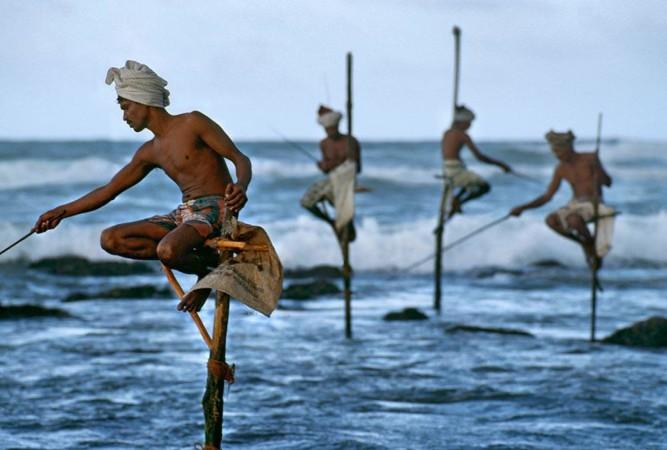
Origine historique et culturelle de la pêche sur pilotis
Pêche sur pilotis ancienne
La pêche sur pilotis puise ses racines profondément dans l’histoire du Sri Lanka, remontant à plus de 70 ans, après la Seconde Guerre mondiale, lorsque les zones de pêche traditionnelles sont devenues surpeuplées. Cherchant de nouvelles façons de pêcher dans les eaux peu profondes, les pêcheurs locaux ont ingénieusement fabriqué des pilotis à partir de poteaux en bois robustes, leur permettant de se percher au-dessus des vagues et de lancer leurs lignes plus loin en mer. Cette approche innovante a non seulement résolu les défis pratiques de la pêche, mais elle est aussi devenue une pratique culturelle distinctive célébrée le long de la côte sud du Sri Lanka.
Aujourd'hui, la pêche sur pilotis est un témoignage de l'esprit durable des habitants côtiers du Sri Lanka, qui ont préservé cette tradition malgré la modernisation et les changements économiques. Chaque matin et chaque soir, les silhouettes des pêcheurs, se tenant gracieusement en équilibre sur leurs pilotis avec en toile de fond l’océan Indien, évoquent un sens de l'intemporalité et de la tradition qui résonne profondément avec les visiteurs en quête d'expériences culturelles authentiques.
Technique traditionnelle de la pêche sur pilotis
La pêche sur pilotis est autant un art qu'une technique de pêche. La méthode commence par les pêcheurs qui se perchent au sommet de fins pilotis ancrés fermement dans le fond marin, souvent transmis au sein des familles de génération en génération. En équilibre avec une aisance acquise, ils manient une canne et une ligne avec précision, lançant leur ligne dans les eaux azurées où les poissons abondent juste sous la surface. Cet avantage de hauteur leur permet non seulement d'étendre leur portée, mais aussi d'observer plus clairement les mouvements des poissons, garantissant ainsi une prise abondante.
L'équipement utilisé est minimaliste mais efficace : une simple canne et une ligne, parfois complétées par un petit hameçon appâté, délicatement manœuvré pour attirer les poissons sans perturber les eaux tranquilles en dessous. Chaque mouvement est délibéré, affiné par des années d'expérience, reflétant une synergie entre l'homme et la mer qui définit l'essence de la pêche sur pilotis au Sri Lanka.
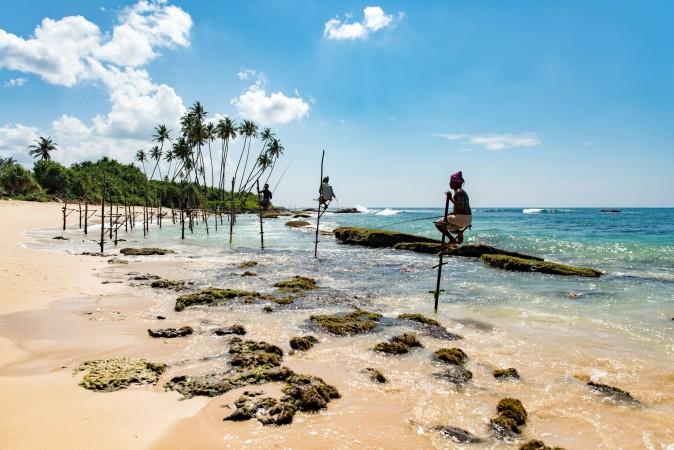
La pêche traditionnelle sur pilotis au Sri Lanka - © Daniel Klein
Influences géographiques et environnementales
Aspects géographiques
La pêche sur pilotis prospère dans des endroits côtiers spécifiques le long des côtes sud et sud-ouest du Sri Lanka, où les eaux peu profondes et les mers calmes offrent des conditions idéales pour cette pratique ancienne. Des régions telles que Weligama, Ahangama et Koggala sont des points chauds renommés, leurs plages de sable et leurs eaux claires attirant à la fois les pêcheurs et les voyageurs curieux.
Aspects environnementaux
Au-delà de son attrait culturel, la pêche sur pilotis met également en évidence l'équilibre délicat entre l'activité humaine et la durabilité environnementale. Les pêcheurs, sensibles aux rythmes saisonniers et écologiques, pratiquent une récolte sélective pour préserver les stocks de poissons et maintenir la santé de l'écosystème. Cette approche consciencieuse garantit que les générations futures pourront continuer à apprécier et à participer à cette tradition vénérable.
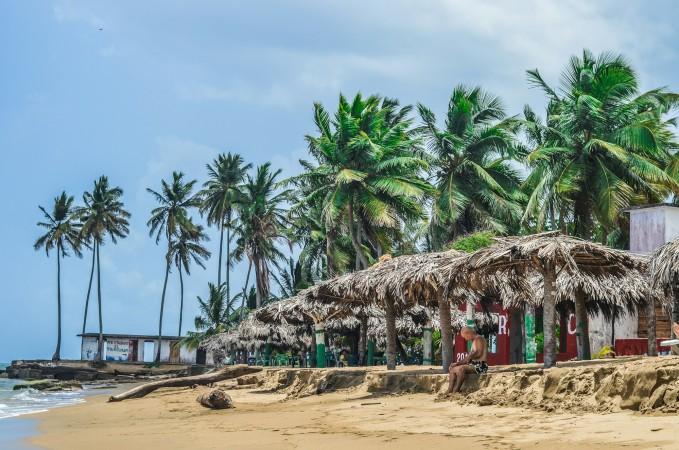
La magnifique plage du Sri Lanka - © Michael Mims
Meilleurs endroits pour voir la pêche sur pilotis au Sri Lanka
Les meilleurs endroits pour voir les pêcheurs sur pilotis se trouvent le long de la côte sud du Sri Lanka. Ces lieux sont non seulement idéaux pour observer la pêche sur pilotis, mais offrent également des vues magnifiques sur la côte sud du Sri Lanka.
- Koggala : Koggala est peut-être l'endroit le plus célèbre pour la pêche sur pilotis au Sri Lanka. Située près de Galle, c'est un emplacement privilégié où vous pouvez voir les pêcheurs perchés sur des pilotis dans les eaux peu profondes de l'océan Indien. Les plages ici offrent une vue emblématique de cette pratique ancestrale, notamment tôt le matin et tard dans l'après-midi, lorsque les pêcheurs sont les plus actifs.
- Weligama : Située un peu plus loin de Koggala, la pêche sur pilotis à Weligama est un autre lieu à visiter. La plage pittoresque et les eaux tranquilles offrent un cadre parfait pour observer les pêcheurs dans leur travail. La ville elle-même est un centre pour les passionnés de surf, ce qui en fait un excellent endroit pour combiner activités culturelles et de loisirs.
- Kataluwa : Près de Koggala, Kataluwa est une autre plage où vous pouvez apercevoir les pêcheurs sur pilotis. Cette zone est moins fréquentée que Koggala, offrant une expérience plus paisible tout en capturant l'essence de cette pratique traditionnelle.
- Ahangama : La pêche sur pilotis à Ahangama est un autre excellent endroit pour observer cette pratique traditionnelle. C'est une destination hors des sentiers battus, offrant une ambiance plus calme et authentique pour ceux qui cherchent à éviter les endroits trop touristiques.
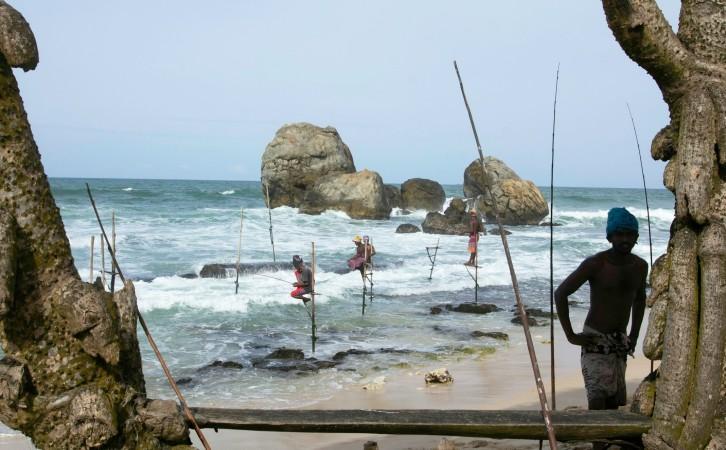
La pêche sur pilotis à Koggala - © Geoff Brooks
Meilleur moment pour voir la pêche sur pilotis
Les moments optimaux pour observer la pêche sur pilotis le long de la côte sud du Sri Lanka sont au lever du soleil et au crépuscule. Les sessions du matin se terminent généralement vers 9 h, lorsque les pêcheurs vendent leur prise – souvent des petits poissons comme le hareng tacheté et le maquereau – aux acheteurs locaux. Le soir, les pêcheurs retournent sur les pilotis, où ils posent pour des photographies et interagissent avec les touristes jusqu'au coucher du soleil. Certains visiteurs aventuriers essaient même leur main à la pêche depuis les pilotis, offrant des tokens de reconnaissance comme des souvenirs ou un soutien financier aux pêcheurs.
Signification culturelle de la pêche sur pilotis
Symbole culturel de la région côtière
La pêche sur pilotis au Sri Lanka dépasse le simple acte de pêche ; elle est un symbole culturel profond, profondément enraciné dans la tradition. La vue des pêcheurs perchés gracieusement sur leurs pilotis est devenue une représentation emblématique dans l'art local et la photographie, symbolisant la tranquillité et l'unité avec la nature. Cette signification culturelle s'étend profondément dans le tissu social des communautés côtières. Transmise de génération en génération, de père en fils, la pêche sur pilotis favorise un sentiment de continuité et d'identité communautaire.
Intersection avec l'ère moderne
La pêche sur pilotis s'aligne étroitement avec les thèmes mondiaux de la durabilité et de la conservation de l'environnement. Son attrait pour les touristes réside non seulement dans son charme pittoresque, mais aussi dans le reflet d'un mode de vie qui valorise l'harmonie avec l'environnement plutôt que les commodités modernes. Avec son impact minimal sur l'écosystème, cette pratique ancienne sert de rappel poignant du patrimoine historique du Sri Lanka et d'un modèle pour les générations futures, en promouvant une relation durable avec la nature.
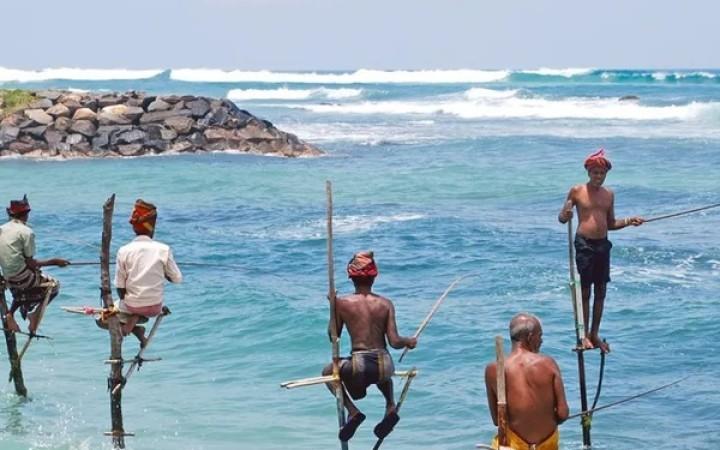
La pêche sur pilotis au lever du soleil - © CafeBiz
Impact de la pêche sur pilotis sur l'économie et l'environnement du Sri Lanka
Impact sur l'économie
La pêche sur pilotis au Sri Lanka influence à la fois l'économie et l'environnement de manière distincte. D'un point de vue économique, elle est essentielle pour maintenir les moyens de subsistance des pêcheurs locaux. Ces pêcheurs vendent généralement leur prise quotidienne directement sur les marchés locaux ou aux touristes, offrant ainsi une source de revenu durable qui ne dépend pas de pratiques de pêche non durables.
Impact sur l'environnement
D'un point de vue environnemental, la pêche sur pilotis se distingue par sa durabilité. Utilisant un équipement minimal et aucun appât, elle minimise les perturbations des habitats marins. La pratique se déroule principalement sur des récifs coralliens naturels, et sa nature à petite échelle garantit un impact écologique minimal. Cette approche illustre une utilisation responsable des ressources, en parfaite adéquation avec les objectifs mondiaux de conservation de l'environnement.
Ainsi, la pêche sur pilotis favorise non seulement la stabilité économique des communautés côtières, mais elle promeut également la gestion environnementale en donnant la priorité à la conservation marine. Son impact dual souligne son importance en tant que modèle de pratiques de pêche durables à l'échelle mondiale, démontrant comment les moyens de subsistance peuvent prospérer sans compromettre la santé de nos océans.
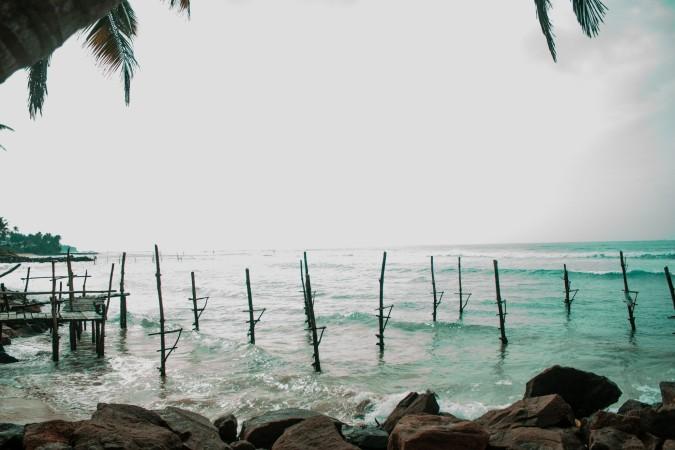
La pêche sur pilotis aide à protéger la vie marine le long de la côte du Sri Lanka - © Tiago Rosado
Efforts de préservation de la pêche sur pilotis au Sri Lanka
La réalité de la pêche sur pilotis au Sri Lanka
La pratique traditionnelle de la pêche sur pilotis au Sri Lanka fait face à des défis contemporains tout en bénéficiant d'efforts soutenus pour sa préservation. Malgré une diminution du nombre de pêcheurs sur pilotis, influencée par des opportunités d'emploi lucratives et l'impact du tourisme croissant, des efforts persistent pour protéger ce patrimoine culturel.
Des lieux historiquement vénérés tels que Mirissa, Koggala et Galle, autrefois animés par des activités de pêche sur pilotis traditionnelles, voient aujourd'hui un changement vers des spectacles destinés à des opportunités photographiques pour les touristes, plutôt que vers de véritables activités de pêche.
Efforts de préservation
En réponse à ces changements, des initiatives de préservation proactives sont en cours pour maintenir la pêche sur pilotis non seulement comme un vestige du passé, mais comme une tradition vivante. Soulignées dans un article récent de The Morning News du Sri Lanka – "Stilt fishing in Koggala" – ces initiatives incluent des programmes éducatifs conçus pour sensibiliser les jeunes générations aux compétences et à l'importance culturelle liées à la pêche sur pilotis. L'objectif est de favoriser un sentiment de fierté et d'engagement pour sa continuation parmi les futurs gardiens de ce patrimoine.
De plus, des organisations locales s'efforcent de trouver un équilibre entre le tourisme et la tradition. Leur priorité est de s'assurer que la pêche sur pilotis conserve sa viabilité économique tout en préservant son authenticité et sa durabilité environnementale.
Ces efforts concertés sont essentiels pour garantir la survie de la pêche sur pilotis face aux défis contemporains. En répondant à ces pressions modernes tout en soulignant son rôle en tant que méthode de pêche durable et pierre angulaire du tissu culturel du Sri Lanka, ces initiatives renforcent son importance et sa pertinence dans le monde actuel.
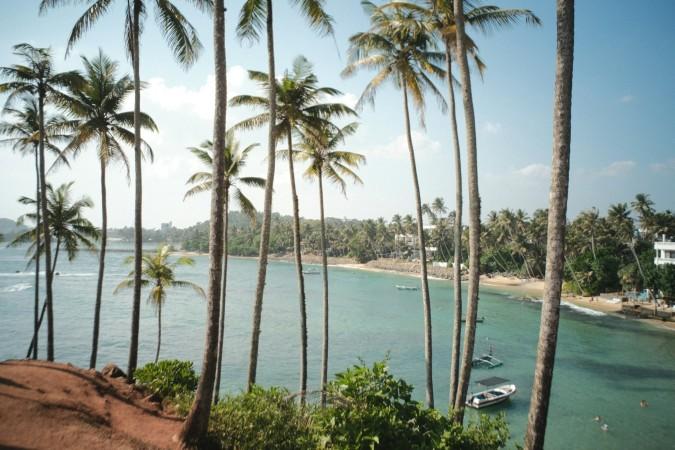
Préserver la pêche sur pilotis, c'est préserver le patrimoine culturel du Sri Lanka - © Austin Curtis
Rejoindre l'effort de préservation et l'écotourisme avec Tweet Tours
Tweet Tours invite les voyageurs à entreprendre un voyage immersif dans l'art traditionnel de la pêche sur pilotis au Sri Lanka. Nos circuits ne vous permettent pas seulement d’observer cette technique de pêche unique, mais vous offrent également l’opportunité de participer activement. Les invités peuvent apprendre directement des pêcheurs locaux, en acquérant des connaissances sur une pratique qui est chérie le long de la côte sud depuis des générations.
Nos circuits au Sri Lanka sont conçus pour offrir une expérience culturelle authentique, où les touristes interagissent directement avec la communauté locale afin de comprendre la profonde signification de la pêche sur pilotis. Au-delà de l’apprentissage des compétences de pêche depuis les pilotis, les participants acquièrent une appréciation des pratiques durables et du patrimoine profondément enraciné dans cette forme traditionnelle de pêche.
Les circuits de pêche sur pilotis font partie d’un package complet qui met en valeur l’attrait du Sri Lanka, alliant patrimoine culturel et paysages naturels à couper le souffle. Les invités peuvent s’attendre à capturer des images saisissantes des pêcheurs en silhouette contre le fond de la beauté pittoresque du Sri Lanka, particulièrement lors des moments magiques du lever et du coucher du soleil.
Pour plus de détails sur nos circuits d'exploration du Sri Lanka et pour découvrir toutes les expériences enrichissantes que nous proposons, notamment si vous prévoyez une lune de miel de luxe au Sri Lanka, visitez notre site web ou contactez notre centre d’appel pour obtenir des informations sur nos offres spéciales et nos arrangements de voyage personnalisés.
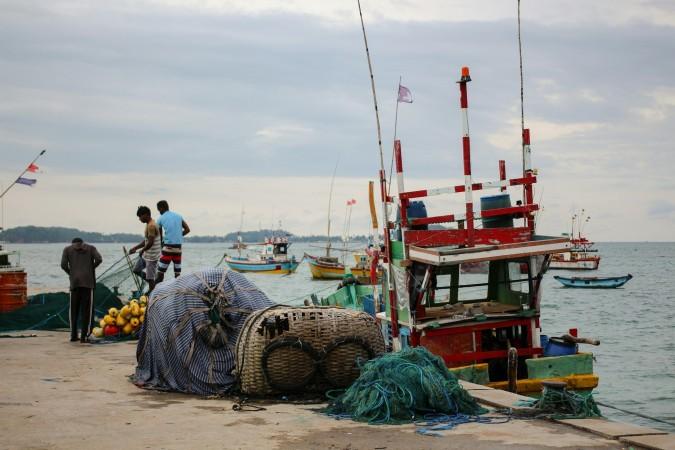
Vivez l'écotourisme avec Tweet Tours - © Ekaterina Boltaga
Conclusion
La pêche sur pilotis au Sri Lanka transcende la simple technique ; elle incarne une profonde connexion entre la tradition, l'environnement et la communauté. En entreprenant des voyages pour explorer cette pratique envoûtante, les voyageurs ne se contentent pas d’observer une tradition séculaire en action, mais ils contribuent également à sa préservation grâce à des pratiques touristiques responsables. En interagissant avec les pêcheurs locaux, en capturant des photographies mémorables et en partageant leurs expériences avec d'autres, les voyageurs jouent un rôle essentiel dans la sauvegarde du patrimoine culturel du Sri Lanka pour les générations futures.
En conclusion, la pêche sur pilotis est un témoignage de la résilience et de l’ingéniosité des communautés côtières du Sri Lanka, offrant un aperçu d’un mode de vie façonné par les rythmes de la mer. Qu'elle soit observée de loin ou vécue de près, la pêche sur pilotis invite les voyageurs à découvrir la beauté de la tradition et l'attrait de l'échange culturel dans l'une des destinations les plus captivantes d'Asie.
Des articles pour vous

Explore Fukushima - Japan Travel, Asia
Nestled in Japan's scenic Tohoku region, Fukushima offers travelers a unique blend of historical charm, cultural richness, and natural beauty. Known for its stunning landscapes and welcoming communities, Fukushima is an excellent destination for those seeking an authentic Japanese experience beyond the bustling metropolises. Renowned for its diverse attractions, from ancient castles and hot springs to vibrant festivals and picturesque countryside, Fukushima offers a great opportunity for cultural and historical exploration for anyone who loves Japanese culture.
Population: Approximately 1.8 million in 2023.
Economy: Specializing in the seafood and fishing industries, Fukushima, with its historical impacts, now continues to thrive as one of the most developed and largest economies in Japan.
Landmarks: Famous for Aizu-Wakamatsu Castle, Fukushima City Historical Museum, and Ouchi-juku.

La symphonie saisonnière de l'Inde : Révéler les meilleurs moments pour explorer le sous-continent
Les traditions anciennes dansent avec les merveilles modernes dans une terre où les épices et l'encens embaument l'air, et chaque recoin cache une histoire prête à être découverte. L'Inde, vaste et diverse, se déploie comme un monde miniature en soi. Mais quand devriez-vous entreprendre ce voyage épique ? Rejoignez-nous pour un tourbillon à travers la tapisserie saisonnière de l'Inde et trouvez le moment parfait pour votre aventure.

Voyage culinaire à travers la Chine : Savourez les saveurs diversifiées
Des rives subtropicales de Canton aux steppes balayées par le vent du Xinjiang, le vaste paysage de la Chine est une tapisserie de saveurs, chaque région mettant en avant ses propres trésors culinaires. Avec plus de 2000 miles séparant les palais de dim sum du sud des étals de kebabs du nord-ouest, et des woks crépitants entre les deux, la diversité gastronomique de la Chine est véritablement inégalée. Alors, prenez vos baguettes et embarquez pour une aventure gourmande à travers les plats les plus délicieux du Royaume du Milieu !

Vivez l'expérience à bord du RV Indochine II - Une croisière sur le Mékong
Le RV Indochine II est un navire de croisière fluviale de luxe, offrant un voyage inoubliable à travers de nombreuses attractions le long du fleuve Mékong. Construit en 2017, ce vaisseau haut de gamme allie élégance coloniale et commodités modernes pour créer un environnement à la fois confortable et élégant pour son équipage et ses passagers. La taille intime du navire en fait le choix idéal pour ceux qui recherchent une expérience de croisière plus personnelle tout en explorant la culture, les paysages et le patrimoine riches du Vietnam et du Cambodge. Que vous admiriez le paysage depuis votre balcon privé ou que vous dégustiez une cuisine locale authentique, le RV Indochine II promet une aventure exotique hors du commun.

Assistez à la pêche sur pilotis au Sri Lanka
Le Sri Lanka, réputé pour ses plages magnifiques et son riche patrimoine culturel, abrite une tradition unique qui captive les voyageurs depuis des siècles : la pêche sur pilotis. Cette pratique ancienne, transmise de génération en génération au sein des communautés côtières, allie art et nécessité, offrant un aperçu d'un mode de vie intimement lié aux rythmes côtiers de l'île. La pêche sur pilotis au Sri Lanka n'est pas simplement un moyen de capturer des poissons ; c'est un emblème culturel, incarnant la résilience et l'ingéniosité des communautés de pêcheurs sri-lankaises.

À l'assaut des sommets : guide du randonneur de l'Himalaya
Lorsque les premiers rayons du soleil teintent les sommets enneigés de doré et de rose, vous êtes au seuil de l'aventure. Bienvenue dans l'Himalaya, où chaque pas est une immersion dans le plus grand spectacle de la nature. Avec Tweet World Travel comme guide, préparez-vous à un trek d’aventures, qui éveillera vos sens et vous transformera à jamais.
